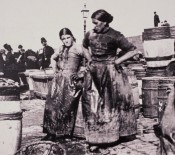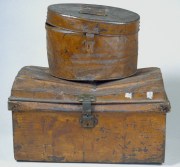Herring Home | Sale and Processing of herring | Next
Workforce of women - lives of the women
Gutting work was hard, and the women were expected to work long hours. They worked six-day weeks, but never on a Sunday, when they attended church. They would usually start work when they left school, at about 15 years old. Many were taught the trade by their mothers.

If the catch was good, the women might start at 5 am and not finish until midnight. They had to work non-stop until all the catch was gutted and packed. If they were lucky, a friend would bring a 'piece' and a mug of tea, which would be eaten as they worked. They often sang while they waited for the fish and if there was any spare time, they would get out their knitting (they knitted clothes for the fishermen and for the stores back home). The teams worked outside in all weathers. They wore oilskin overalls to protect their clothes and keep them clean and dry. Later on they also wore heavy duty Wellington boots. The gutters wrapped their fingers in strips of cloth to protect them from the sharp knives and the brine. The cloths also helped them to hold the slippery fish.

When the women were working away from home they carried their luggage in a wooden or tin chest or kist, They also used this as a seat. The teams travelled to places such as Great Yarmouth and Lowestoft in special trains. In larger ports where accommodation was available they lived in digs near the harbour. In other areas, such as the Shetland Isles, they lived in huts at the curing yards, which they would often decorate themselves at the beginning of the season.
The women received a small sum in 'arles' on engagement, and thereafter they were paid per barrel packed. A crew carried out the whole curing process for the barrels and they were also paid time rates for general work. Earning depended on the speed and skill of the team, with girls working for their first season paid less. Full pay settlement was made at the end of the season.